How to make homemade Lotus Seed Paste for use in Asian breads and cakes. Recipe with step-by-step photos.
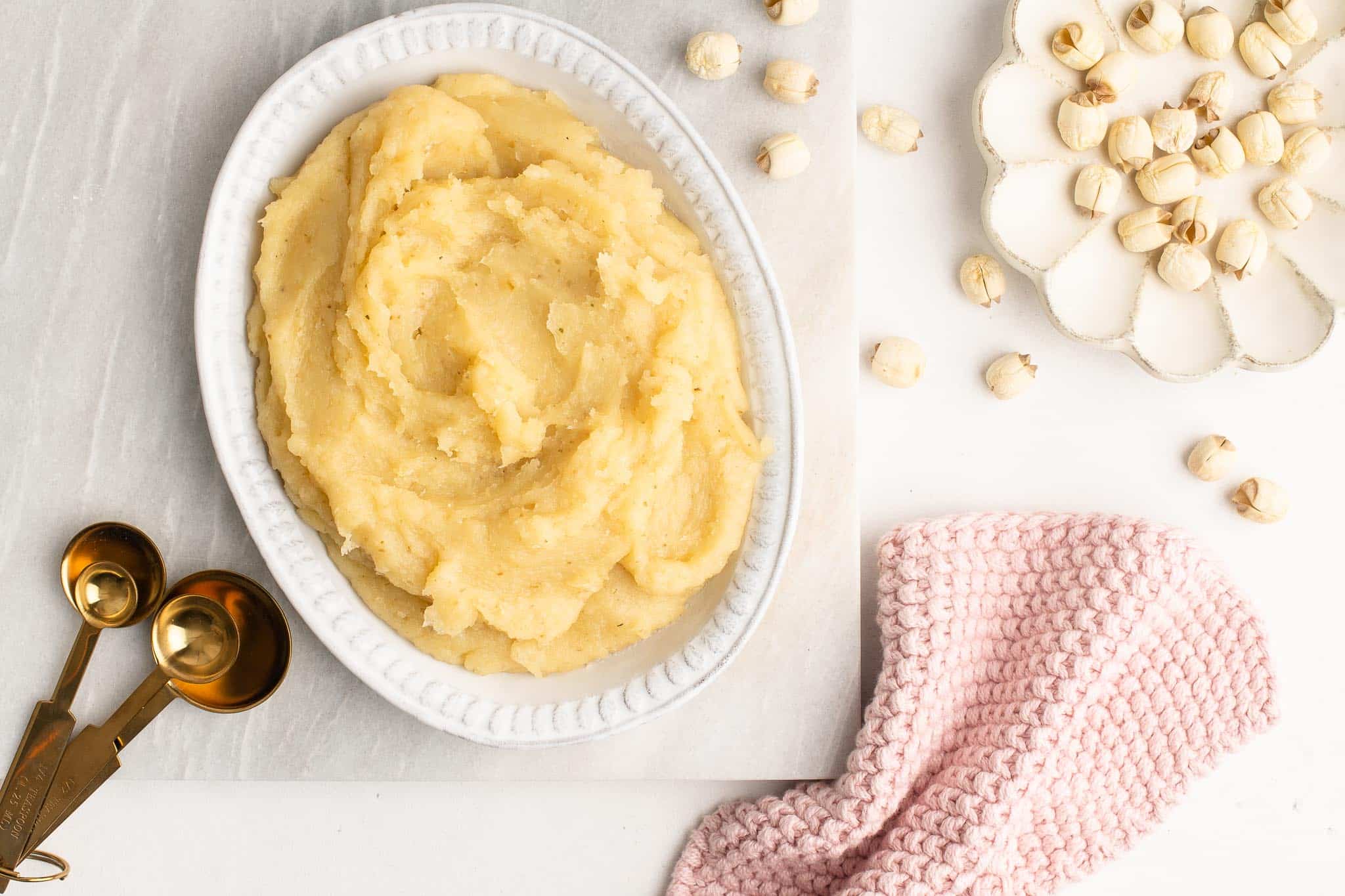
Lotus Seed Paste
Many Asian breads and cakes contain a sweet paste-like filling, and Lotus Seed Paste is a popular option. Lotus Seed Paste is very mild in flavour and has no distinct smell like some other Asian pastes used in baked goods. It is one of my favourite filling for Mooncakes.
As the name suggests, it is made from dried lotus seeds which are rehydrated, cooked until soft, and then processed into a smooth purée.
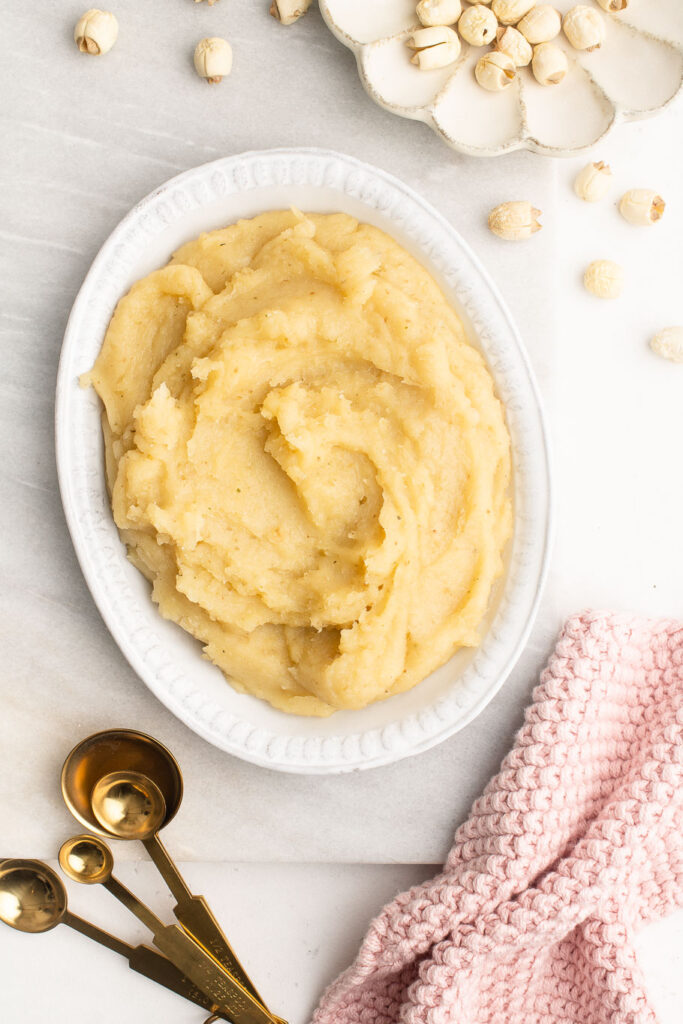
Homemade Lotus Seed Paste
It is possible to buy ready-made lotus seed paste in some Asian grocery stores, but making your own means that it tastes fresher and with no preservatives added, plus you can control the sweetness of the paste.
A homemade Lotus Seed Paste will taste different to the ready-made product; it is usually coarser and drier in texture, whereas the ready-made version is typically very smooth. I think there is a place for both versions, but I also like that friends and family can tell when Lotus Seed Paste is homemade because it simply looks and tastes more rustic.
Making your own Lotus Seed Paste might feel like a lengthy task, but the results are definitely worth it. It’s one of those recipes which might require a lot of time, but it is very easy to make.
Dried Lotus Seeds
To make your own Lotus Seed Paste, you will need to buy dried lotus seeds, which are commonly available from most Asian grocers and they are quite cheap.
Look for the variety which have been split and where the green germ in the centre of the seeds have already been removed. Otherwise, once you have soaked the seeds, you will need to remove these green germs from every individual seed before proceeding with the rest of the recipe (which would be a recipe killer for me!).
How to Make Lotus Seed Paste
Step 1
Soak the dried lotus seeds in a large bowl with a lot of water. Soak them for at least 8 hours or overnight.

Step 2
Drain the soaked lotus seeds and transfer them to a large pot. Cover with water and cook them for about 2 hours on medium-high heat on the stove, or for about 15-20 minutes using a pressure cooker or Instant Pot on high pressure.
The seeds are cooked sufficiently when you can mash them easily with a fork. If you taste a seed, it should be very soft with no bite.
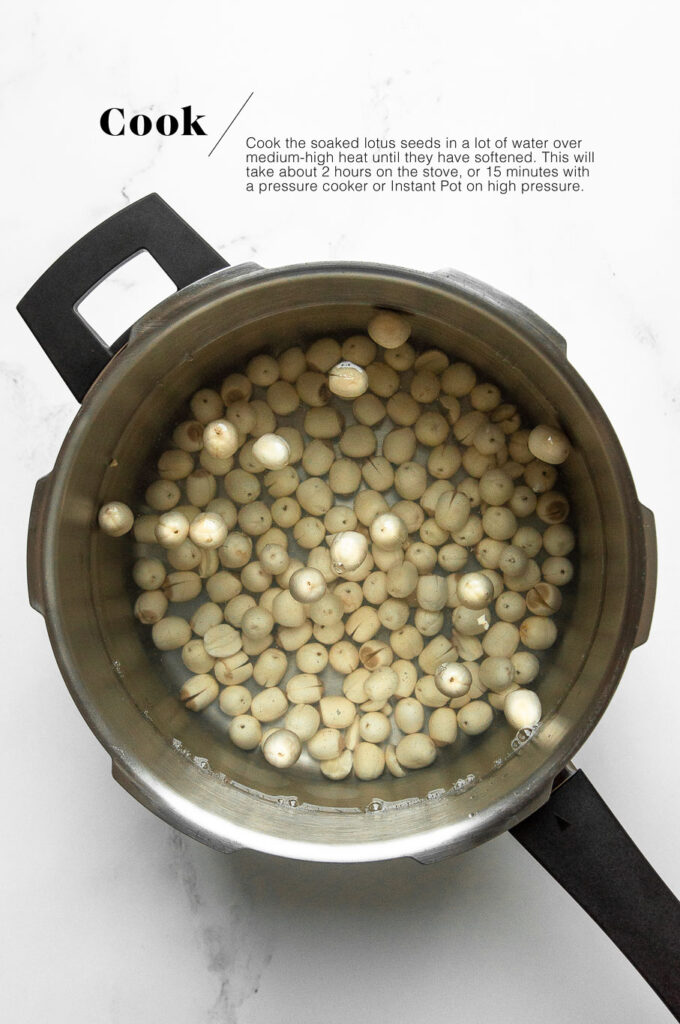
Step 3
Drain the cooked seeds and place them into the bowl of a food processor. Add the sugar and salt.

Step 4
Blitz everything together until you have a smooth purée.
If your mixture looks a bit dry (which could possibly be a sign that your lotus seeds are under-cooked), add some hot water to help everything blend together smoothly. The consistency should be like a wet hummus.
If you are a purist, you might want to pass the purée through a fine sieve to have an ultra-smooth paste. I tried this once and gave up after 30 minutes, by which time I had only pushed through a few tablespoons of the paste through the sieve. The beauty of homemade pastes is that you can get away with a more rustic texture 😉
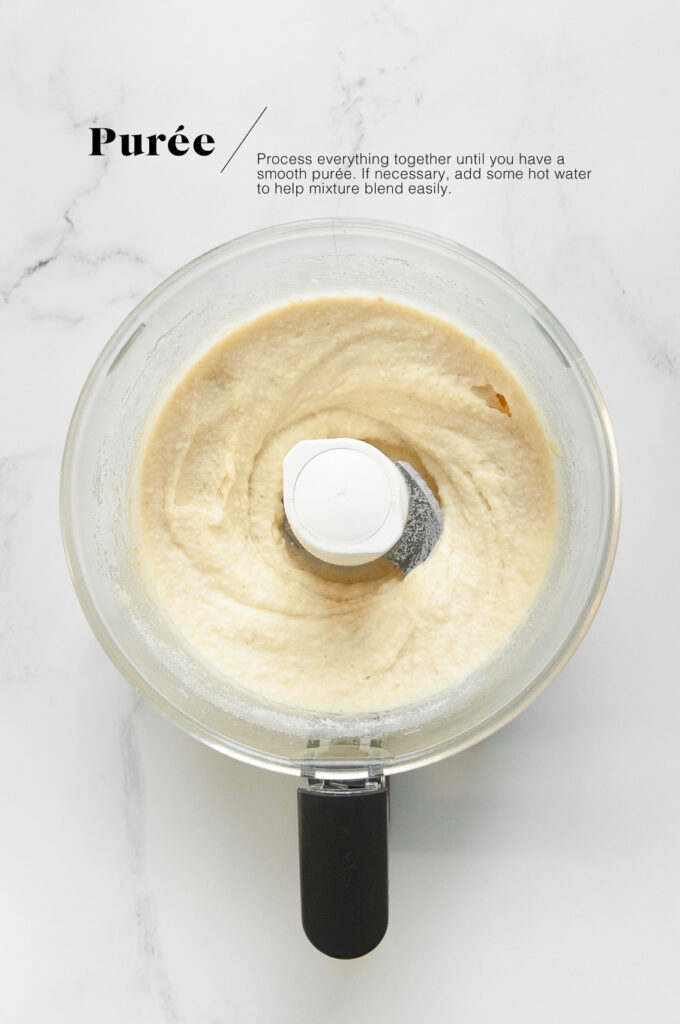
Step 5
Transfer the puréed lotus seeds to a large non-stick pan. Cook the paste over medium-heat, stirring with a firm spatula or wooden spoon to slowly dry out the paste.
Add a tablespoon of oil at a time, stirring it in the mixture to emulsify the paste.
As soon as one tablespoon of oil has been absorbed into the paste, add the next tablespoon of oil.
Keep stirring to ensure that the paste does not stick to the bottom of the pan and burn, and to ensure that the mixture is continually emulsified.
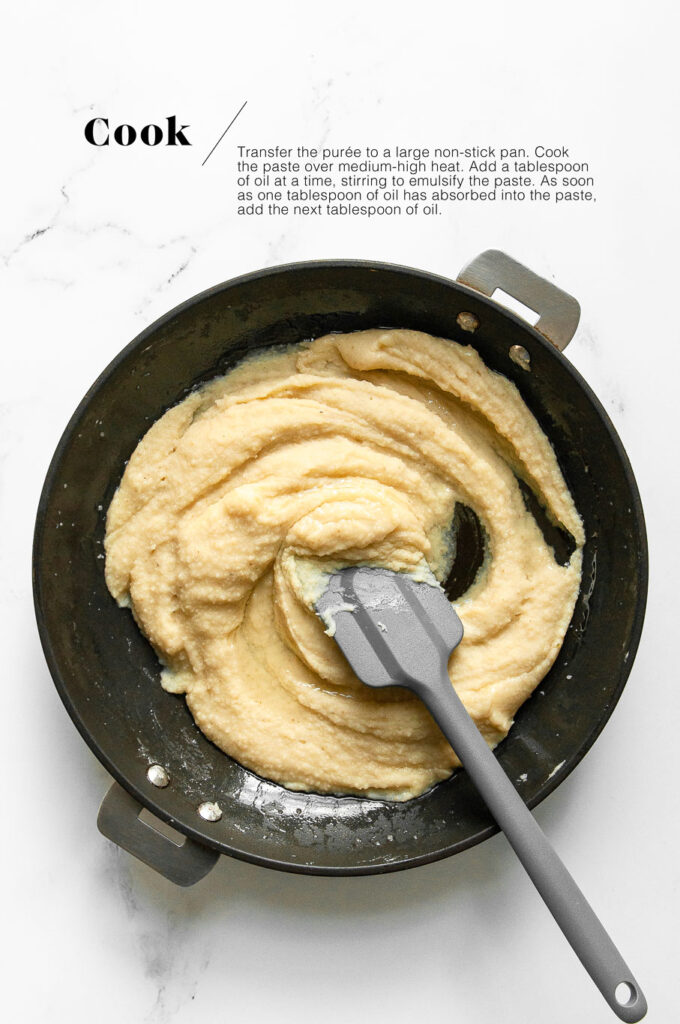
Step 6
As the mixture starts to thicken, start folding the paste from the outer-edges towards the centre. Keep repeating until the mixture holds its shape as you do so and you can form a firm block.
The paste should still be quite smooth and soft, but it will firm up more as it cools.
Transfer the paste to a large bowl or container to let it cool completely before using.
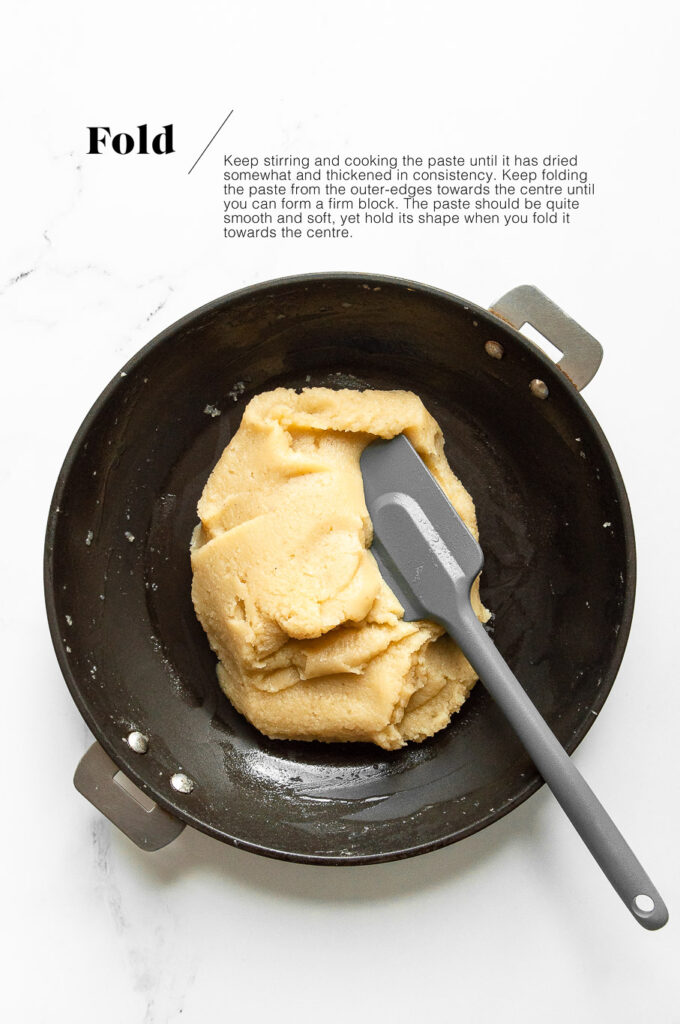
Recipes Using Lotus Seed Paste
Recipes using Lotus Seed Paste include:
Mooncakes with Lotus Seed Paste and Salted Egg Yolk
PrintLotus Seed Paste

- Resting Time: 8 hours
- Prep Time: 5 mins
- Cook Time: 2.5 hours
- Total Time: 0 hours
- Yield: Makes about 2 cups
- Category: Dessert
- Method: Stove
- Cuisine: Chinese
How to make homemade Lotus Seed Paste for use in Asian breads and cakes. Recipe with step-by-step photos.
Ingredients
- 200 g (7 ounces) dried lotus seeds
- 150 g (2/3 cup) caster sugar, or to taste
- pinch of fine salt
- 100 ml (1/3 cup plus 1 tablespoon) sunflower oil (or another flavourless oil)
Instructions
To soak the lotus seeds
- Place the dried lotus seeds into a large bowl.
- Cover the seeds generously with cold water.
- Leave the seeds to soak for at least 8 hours, or overnight.
To cook the lotus seeds
- Drain the lotus seeds.
- If the lotus seeds have a green germ in the centre, you will need to remove them from every seed.
- Place the soaked lotus seeds into a large pot and fill it with cold water. I like to cook the seeds in a lot of water, so I cover the seeds with at least 5-10 cm depth of water.
- Bring the pot to the boil, and then turn it down to a medium simmer.
- Top up with boiling water every 30 minutes or so to keep the water level constant.
- Cook the lotus seeds for about 2 hours on the stove. Alternatively, if you have a pressure cooker or an Instant Pot, you can cook the lotus seeds on high pressure for about 15-20 minutes.
- The lotus seeds are cooked when the seeds can be easily mashed with a fork. If you taste a cooked seed, it should be very soft with no bite.
To purée the lotus seeds
- Drain the cooked lotus seeds.
- Place the cooked seeds into the bowl of a food processor.
- Add the sugar and salt.
- Blitz until you have a very smooth purée. If the mixture is too thick, add a dash of water until you can blend easily. The texture should be like a wet hummus.
To cook the lotus seed paste
- Scrape the mixture into a large non-stick pan.
- Start cooking the paste over medium-high heat.
- Use a spatula or wooden spoon to stir the paste so that the moisture can evaporate from the mixture.
- As you stir, add about a tablespoon of the oil at a time.
- Keep stirring until the oil is well-incorporated into the paste.
- Once the mixture has emulsified, add some more oil.
- Continue until all of the oil has been added.
- Once all of the oil has been added, continue stirring the mixture so that it can thicken.
- Eventually, the goal is to be able to fold the paste from the outer-edges into the centre until the paste is a little firm and can hold its shape. By this stage, the paste will resemble a very soft cookie dough.
- Be careful to not over-cook the paste as it can burn, or it can split, i.e. the paste will separate and look grainy. If this happens, it’s probably too late to rescue the paste, but you can try by adding a splash of water and mixing everything together furiously.
- Transfer the paste to a large bowl and let it cool completely. The paste will firm up more as it cools.
- If you are making this paste ahead of time, you can keep it in an air-tight container in the fridge for several days.
Kitchen Notes
 OVEN & STOVE TEMPERATURES
OVEN & STOVE TEMPERATURES
All recipes on this website have been tested on an induction stove and/or with a conventional oven (i.e. an oven without fan). All recipes on this website use temperatures for a conventional oven, unless otherwise mentioned. Convection ovens (i.e. fan-forced ovens) are typically 20°C/70°F hotter than conventional ovens, but please check your manufacturer’s handbook.
 CONVERSIONS
CONVERSIONS
To convert from cups to grams, and vice-versa, please see this handy Conversion Chart for Basic Ingredients.
 Print
Print Pin Recipe
Pin Recipe Rate
Rate
Hi there,
I see other recipes for lotus seed paste use maltose. Did you forget to add this to your ingredients or do you leave it out completely? Do you think the maltose will make a big difference to the taste?
Hi Jenny,
No, I don’t use maltose in my recipe, mostly because it’s not readily available where I live. I don’t think it will make a big difference to the taste. But if it is easy to find where you live, you could add a touch of maltose to a small portion of the lotus seed paste to see how it tastes.
Your photos are very helpful. Thank you! I just started to soak my lotus seeds now and hope to make the paste later this evening. I love your website!
Hi Katy,
Hope you will enjoy this recipe!
Bonjour, merci pour cette recette que je vais tester cette année. Par contre, je n’ai trouvé que des conserves de graines de lotus. Je sais que le goût sera moins bon, mais tant pis. Par contre j’ai un souci de conversion : quel est le poids des graines une fois réhydratées ? Merci pour votre aide
Bonjour Citha,
Malheureusement, je ne connais pas le poids des graines de lotus une fois hydratées. Je le noterai la prochaine fois que je cuisinerai la recette. Je n’ai pas essayé non plus de faire de la pâte de lotus avec des graines de lotus en conserve. S’ils sont conservés dans du sirop, cela pourrait affecter le goût. Selon que les graines de lotus en conserve sont déjà cuites ou non, vous pouvez probablement simplement les égoutter et les utiliser immédiatement en ajoutant du sucre si nécessaire. Bonne chance avec la recette!